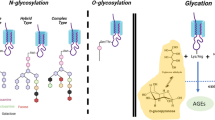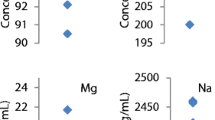Abstract
Indoxylsulfate (IS) and p-cresylsulfate (PCS) are natural compounds endowed with toxicity. These molecules are harmful to the environment and removed by the procedure of dialysis. Knowledge of their interaction with biologic compounds such as proteins and particularly human serum albumin (HSA) is limited. This study was therefore designed to determine the thermodynamic parameters of the interaction of IS with HSA and in competition with PCS. Results showed that IS binding is moderate (K a = 1,750 ± 39 M−1). The interaction is mainly electrostatic (∆H° = −36.2 ± 1.7 kJ mol−1) and yields a modification of conformation upon binding (∆conf S° < 0). The thermodynamic parameters obtained at different temperatures show an enthalpy–entropy compensation process. Competition with PCS reveals that affinity for IS decreased by 36 %, with profound modification of the binding forces involved and a release of PCS from the binding site.



Similar content being viewed by others
References
Singh RK, Kumar S, Kumar S, Kumar A. Development of parthenium based activated carbon and its utilization for adsorptive removal of p-cresol from aqueous solution. J Haz Mat. 2008;155:523–35.
Bone E, Tamm A, Hill M. The production of urinary phenols by gut bacteria and their possible role in the causation of large bowel cancer. Am J Clin Nutr. 1976;29:1448–54.
Agency for Toxic Substances and Disease Registry. Toxicological profiles for cresols (draft). Atlanta: US public Health Service, US Department of Health & Human Services; 1990.
Brunet P, Dou L, Cerini C, Berlan Y. Protein-bound uremic retention solutes. Adv Renal Replace Th. 2003;10–4:310–20.
Vanholder R, De Smet R, Glorieux G, Argilés A, Baurmeister U, Brunet P, Clark W, Cohen G, De Deyn PP, Deppisch R, Descamps-Latscha B, Henle T, Jörres A, Lemke HD, Massy ZA, Passlick-Deetjen J, Rodriguez M, Stegmayr B, Stenvinkel P, Tetta C, Wanner C, Zidek W. Review on uremic toxins: classification, concentration and interindividual variability. Kidney Int. 2003;63:1934–43.
Kun R, Szekeres M, Dekany I. Isothermal titration calorimetry studies of the pH induced conformational changes of bovine serum albumin. J Therm Anal Calorim. 2009;96:1009–17.
Bergé-Lefranc D, Chaspoul F, Calaf R, Charpiot P, Brunet P, Gallice P. Binding of p-cresylsulfate and p-cresol to human serum albumin studied by calorimetry. J Phys Chem B. 2010;114:1661–5.
Painter L, Harding MH, Beeby PJ. Synthesis and interaction with human serum albumin of the first 3,18-disubstituted derivative of bilirubin. J Chem Soc Perkin Trans. 1998;18:3041–4.
Wiseman T, Williston S, Brandts JF, Lin LN. Rapid measurement of binding constants and heats of binding using a new titration calorimeter. Anal Biochem. 1989;179:131–7.
Brown A. Analysis of cooperativity by isothermal titration calorimetry. Int J Mol Sci. 2009;10:3457–77.
Reynold JA, Herbert S, Polet H, Steinhardt J. The binding of divers detergent anions to bovine serum albumin. Biochemistry. 1967;6:937–47.
Velazquez-Campoy A, Todd MJ, Freire E. HIV-1 protease inhibitors: enthalpic versus entropic optimization of the binding affinity. Biochemistry (USA). 2000;39:2201–7.
Ghuma J, Zunszai PA, Petitpas I, Bhattacharya AA, Otagiri M, Curry S. Structural basis of the drug-binding specificity of human serum albumin. J Mol Biol. 2005;353:38–52.
Quinlan GJ, Martin GS, Evans TW. Albumin: biochemical properties and therapeutic potential. Hepatology. 2005;41:1211–9.
Ball V, Maechling C. Isothermal microcalorimetry to investigate non specific interactions in biophysical chemistry. Int J Mol Sci. 2009;10:3283–315.
Dunitz JD. Win some, lose some: enthalpy–entropy compensation in weak intermolecular interactions. Chem Biol. 1995;2:709–12.
Zielenkiewicz W, Terekhova IV, Wszelaka-Rylik M, Kumeev RS. Thermodynamics of inclusion complex formation of hydroxypropylated a- and b-cyclodextrins with aminobenzoic acids in water. J Therm Anal Calorim. 2010;101:15–23.
Bouchemal K, Couvreur P, Daoud-Mahammed S, Poupaert J, Gref R. A comprehensive study on the inclusion mechanism of benzophenone into supramolecular nanoassemblies prepared using two water-soluble associative polymers. J Therm Anal Calorim. 2009;98:57–64.
Searle MS, Westwell MS, Williams DH. Application of a generalised enthalpy–entropy relationship to binding co-operativity and weak associations in solution. J Chem Soc Perkin Trans 2. 1995;1:141–51.
Galan JJ, Rodriguez JR. Thermodynamic study of the process of micellization of long chain alkyl pyridinium salts in aqueous solution. J Therm Anal Calorim. 2010;101:359–64.
Olsson TS, Ladbury JE, Pitt WR, Williams MA. Extent of enthalpy–entropy compensation in protein–ligand interactions. Protein Sci. 2011;20(9):1607–18.
Cooper A, Johnson CM, Lakey JH, Nollmann M. Heat does not come in different colours: entropy–enthalpy compensation, free energy windows, quantum confinement, pressure perturbation calorimetry, solvation and the multiple causes of heat capacity effects in biomolecular interactions. Biophys Chem. 2001;93:215–30.
Banerjee T, Singh SK, Kishore N. Binding of naproxen and amitriltyline to bovine serum albumin: biophysical aspects. J Phys Chem B. 2006;110:24147–56.
Baker BM, Kenneth P, Murphy KP. Dissecting the energetics of a protein–protein interaction: the binding of ovomucoid third domain to elastase. J Mol Biol. 1997;268:557–69.
Murphy KP. Hydration and convergence temperatures: on the use and interpretation of correlation plots. Biophys Chem. 1994;51:311–26.
Baldwin RL. Temperature dependence of the hydrophobic interaction in protein folding. Proc Natl Sci USA. 1986;83:8069–72.
Murphy KP, Privalov PL, Gill SJ. Common features of protein unfolding and dissolution of hydrophobic compounds. Science. 1990;247:559–61.
Xi J, Fan L. Study on the binding of puerarin to bovine serum albumin by isothermal titration calorimetry and spectroscopic approaches. J Therm Anal Calorim. 2010;102:217–23.
Jha NS, Kishore N. Binding of streptomycin with bovine serum albumin: energetics and conformational aspects. Thermochim Acta. 2009;482:21–9.
Zakariassen H, Sorlie M. Heat capacity changes in heme protein–ligand interactions. Thermochim Acta. 2007;464:24–8.
Chang CEA, Chen W, Gilson MK. Analysis of the change in ligand entropy upon protein binding. Proc Natl Acad Sci USA. 2007;104:1534–9.
Singh N, Warshel A. A comprehensive examination of the contributions to the binding entropy of protein–ligand complexes. Proteins. 2010;78(7):1724–35.
Davilas A, Koupparis M, Macheras P, Valsami G. In-vitro study on the competitive binding of diflunisal and uraemic toxins to serum albumin and human plasma using a potentiometric ion-probe technique. J Pharm Pharmacol. 2006;58:1467–74.
Mingrone G, De Smet R, Greco AV, Bertuzzi A, Gandolfi A, Ringoir S, Vanholder R. Serum uremic toxins from patients with chronic renal failure displace the binding of l-tryptophan to human serum albumin. Clin Chim Acta. 1997;260:27–34.
Meijers BKI, De Loor H, Bammens B, Kristin V, Vanrenterghem Y, Evenepoel P. p-Cresyl sulfate and indoxyl sulfate in hemodialysis patients. Clin J Am Soc Nephrol. 2009;4:1932–8.
Watanabe H, Nogushi T, Miyamoto Y, Kotani S, Nakajima S, Ishima Yu, Otagiri M, Maruyama T. Interaction between two sulfate conjugated uremic toxins, p-cresylsulfate and indoxylsulfate, during binding with human serum albumin. Drug Metab Dispos. 2012;40:1423–8.
Sakai T, Takadate A, Otagiri M. Characterisation of binding site of uremic toxins on human serum albumin. Biol Pharm Bull. 1995;18(12):1755–61.
Acknowledgments
Authors would like to thank Raymond Calaf, Philippe Charpiot and Caroline Montet for their helpful discussions.
Author information
Authors and Affiliations
Corresponding author
Rights and permissions
About this article
Cite this article
Bergé-Lefranc, D., Chaspoul, F., Cérini, C. et al. Thermodynamic study of indoxylsulfate interaction with human serum albumin and competitive binding with p-cresylsulfate. J Therm Anal Calorim 115, 2021–2026 (2014). https://doi.org/10.1007/s10973-013-3067-6
Received:
Accepted:
Published:
Issue Date:
DOI: https://doi.org/10.1007/s10973-013-3067-6




